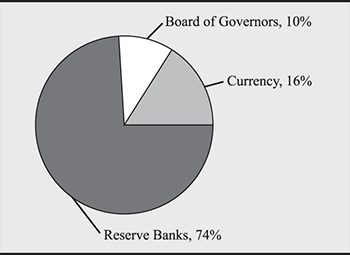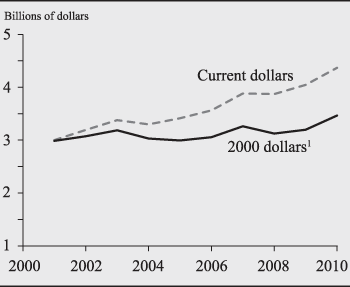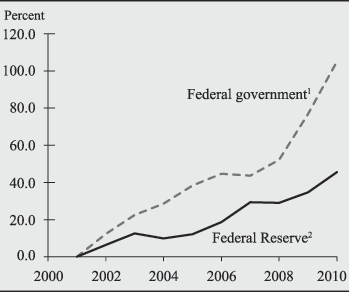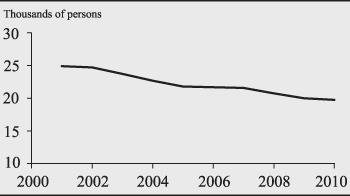Budgets: Chapter 1. Federal Reserve System
Total expenses for the Federal Reserve System for 2010 are budgeted at $4,368.4 million, an increase of 8.1 percent from 2009 actual expenses. Of this total, $3,221.3 million is for the Reserve Banks, $444.2 million is for the Board of Governors, and $702.9 million is for the cost of new currency (tables 1.1 and 1.2). Revenue from priced services provided to depository institutions is expected to total $565.9 million, or 13 percent of total budgeted expenses. This revenue, combined with claims for reimbursement and other income, results in the recovery of approximately 24 percent of the System's budgeted 2010 expenses.1 When these items are deducted from budgeted 2010 expenses, net expenses for the System are 14.5 percent higher than 2009 net expenses (table 1.1), primarily because of a decline in priced services revenue and an increase in currency expenses.
The distribution of budgeted expenses is similar to that in previous years, with the Reserve Banks' expenses accounting for 74 percent of the total, new currency expenses accounting for 16 percent, and Board expenses accounting for the remainder (chart 1.1).
System employment is budgeted at 19,768 for 2010, a decrease of 281 from the 2009 level, largely because of planned staff reductions by the Reserve Banks.
| Item | 2008 (actual) | 2009 (actual) | 2010 (budgeted) | Percent change | |
|---|---|---|---|---|---|
| 2008-2009 | 2009-2010 | ||||
| Total System expenses1 | 3,872.4 | 4,041.4 | 4,368.4 | 4.4 | 8.1 |
| Less | |||||
| Revenue from priced services | 873.8 | 675.4 | 565.9 | -22.7 | -16.2 |
| Claims for reimbursement2 | 461.1 | 450.3 | 463.2 | -2.3 | 2.9 |
| Other income | 1.3 | 1.3 | 1.2 | 2.0 | -7.1 |
| Equals | |||||
| Net System expenses | 2,536.2 | 2,914.4 | 3,338.1 | 14.9 | 14.5 |
NOTE: Components may not sum to totals and may not yield percentages shown because of rounding. Total expenses reflect all redistributions for support and overhead and exclude capital outlays.
1. With the 2009 Annual Report: Budget Review, a change was made in the way expenses were presented: The costs of printing and transporting currency, and related expenses, were included in total System expenses, to align with the presentation in the Board's Annual Report. Relevant figures for 2008 also include currency expenses, which, in reports prior to 2009, were shown as a memo item. Return to table
2. Costs of fiscal agency and depository services provided to the U.S. Treasury, other government agencies, and other fiscal principals that are billed to these agencies. Return to table
| Item | 2008 (actual) | 2009 (actual) | 2010 (budgeted) | Percent change | |
|---|---|---|---|---|---|
| 2008 to 2009 | 2009 to 2010 | ||||
| Reserve Banks1 | 3,020.8 | 3,142.5 | 3,221.3 | 4.0 | 2.5 |
| Personnel | 2,021.3 | 2,155.7 | 2,201.4 | 6.6 | 2.1 |
| Nonpersonnel | 999.5 | 986.9 | 1,019.9 | -1.3 | 3.4 |
| Board of Governors2 | 351.2 | 396.8 | 444.2 | 13.0 | 11.9 |
| Personnel | 268.2 | 294.1 | 319.0 | 9.7 | 8.5 |
| Nonpersonnel | 83.0 | 102.7 | 125.2 | 23.7 | 21.9 |
| Currency3 | 500.4 | 502.1 | 702.9 | .3 | 40.0 |
| Total System expenses | 3,872.4 | 4,041.4 | 4,368.4 | 4.4 | 8.1 |
NOTE: Expenses exclude capital outlays. Components may not sum to totals and may not yield percentages shown because of rounding.
1. For detailed information on Reserve Bank expenses, see chapter 3. Return to table
2. Includes extraordinary items and expenses of the Office of Inspector General. See also chapter 2. Return to table
3. For more information on currency expenses, see chapter 4. Return to table
Chart 1.1Distribution of Budgeted Expenses of the Federal Reserve System, 2010

d
2010 System Budget Initiatives
The Reserve Bank budgets are funding increases in the central bank functions, specifically supervision and regulation, loans to depository institutions and others, and cash operations, offset by reductions in check operations. The major factors affecting the 2010 Reserve Bank budgets are outlined in more detail in chapter 3.
Trends in Expenses and Employment
From the actual 2001 level to the budgeted 2010 amount, the total expenses of the Federal Reserve System have increased an average of 4.3 percent per year (1.9 percent per year when adjusted for inflation) (chart 1.2). Over the same period, nondefense discretionary spending by the federal government has increased an average of 8.3 percent per year (chart 1.3). Over the 2001-2010 period, Federal Reserve System employment has decreased by 5,140 (chart 1.4).
Total Expenses of the Federal Reserve System, 2000-2010

NOTE: Includes extraordinary items and expenses of the Office of Inspector General.
1. Calculated with GDP price deflator.
d
Cumulative Change in Federal Reserve System Expenses and Federal Government Expenses, 2000-2010

NOTE: For 2010, budgeted.
1. Discretionary spending less expenditures on defense. Source: Budget of the United States Government, Fiscal Year 2010: Historical Tables, Table 8.1 Outlays by Budget Enforcement Act Category, 1962-2014.
2. Includes extraordinary items and expenses of the Office of Inspector General.
d
Employment in the Federal Reserve System, 2001-2010

NOTE: For 2010, budgeted.
d
The primary factors influencing both Reserve Bank spending restraint and the substantial staffing decreases over the past 10 years have been restructuring efforts in the check-processing function and efficiency measures in the support and overhead functions. Over the same 10-year period, check costs decreased an average of 9.5 percent and check staff declined an average of 17.8 percent annually. Local support and overhead costs increased an average of 1.7 percent annually and the associated staffing level declined an average of 3.1 percent annually over the same 10-year period.
2010 Capital Budgets
The capital budgets for the Reserve Banks and the Board total $458.0 million, with $434.4 million budgeted for the Reserve Banks and Federal Reserve Information Technology and $23.6 million budgeted for the Board. As in previous years, the 2010 capital budgets include funding for projects that support the strategic direction outlined by the individual Reserve Banks, System business leaders, and the Board. These strategic goals focus on investments that continue to improve operational efficiencies, enhance services to bank customers, and ensure a safe, high-quality work environment. More-detailed discussions of the Board and Reserve Bank capital budgets are included in chapters 2 and 3, respectively.
Footnotes- Claims for reimbursement refers to costs of fiscal agency and depository services provided to the U.S. Treasury, other government agencies, and other fiscal principals that are billed to these agencies. Other income comes from services provided on behalf of the U.S. Treasury that are paid for by the depository institutions using the services, which include the transfer of funds between depository institutions and the Treasury. Return to text


 Previous
Previous